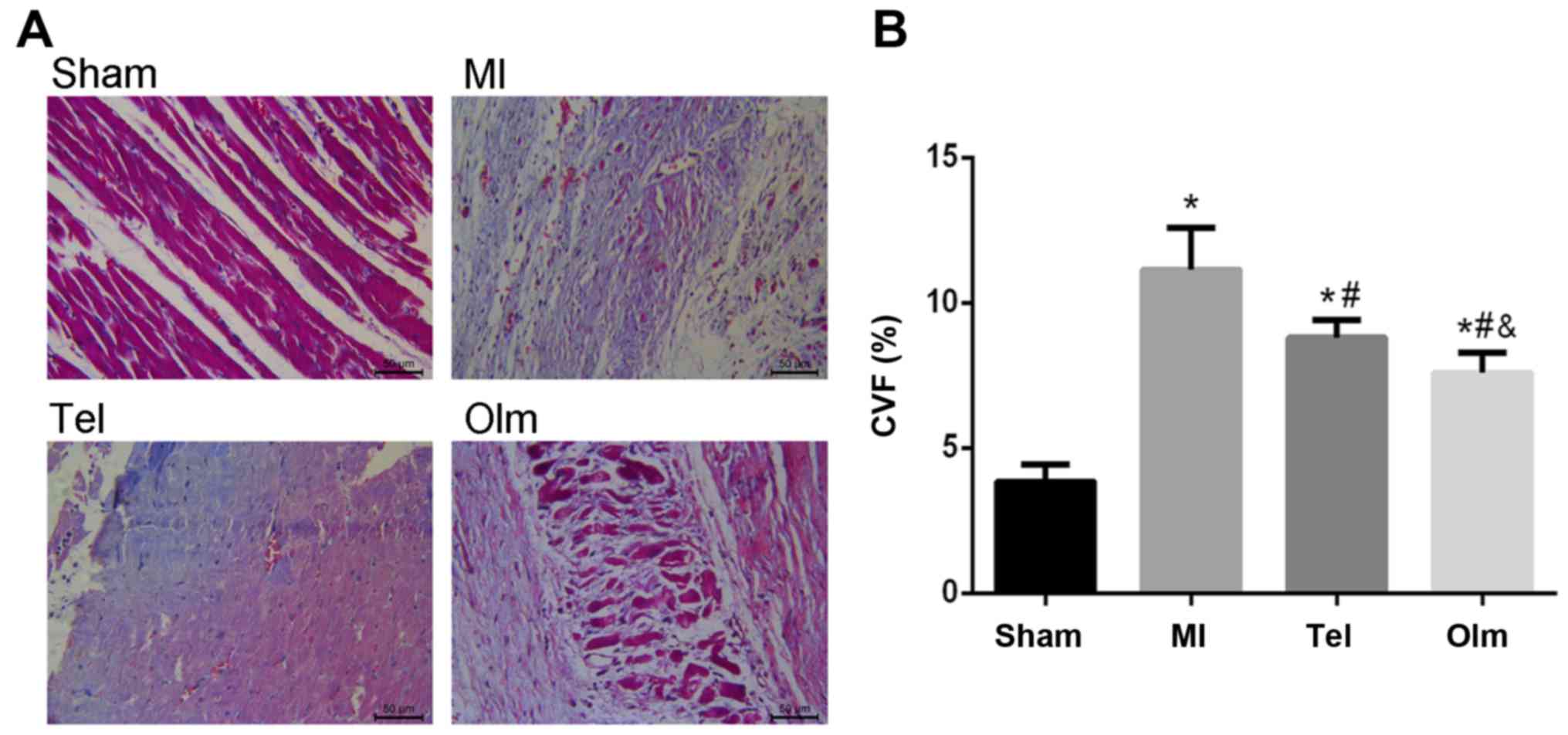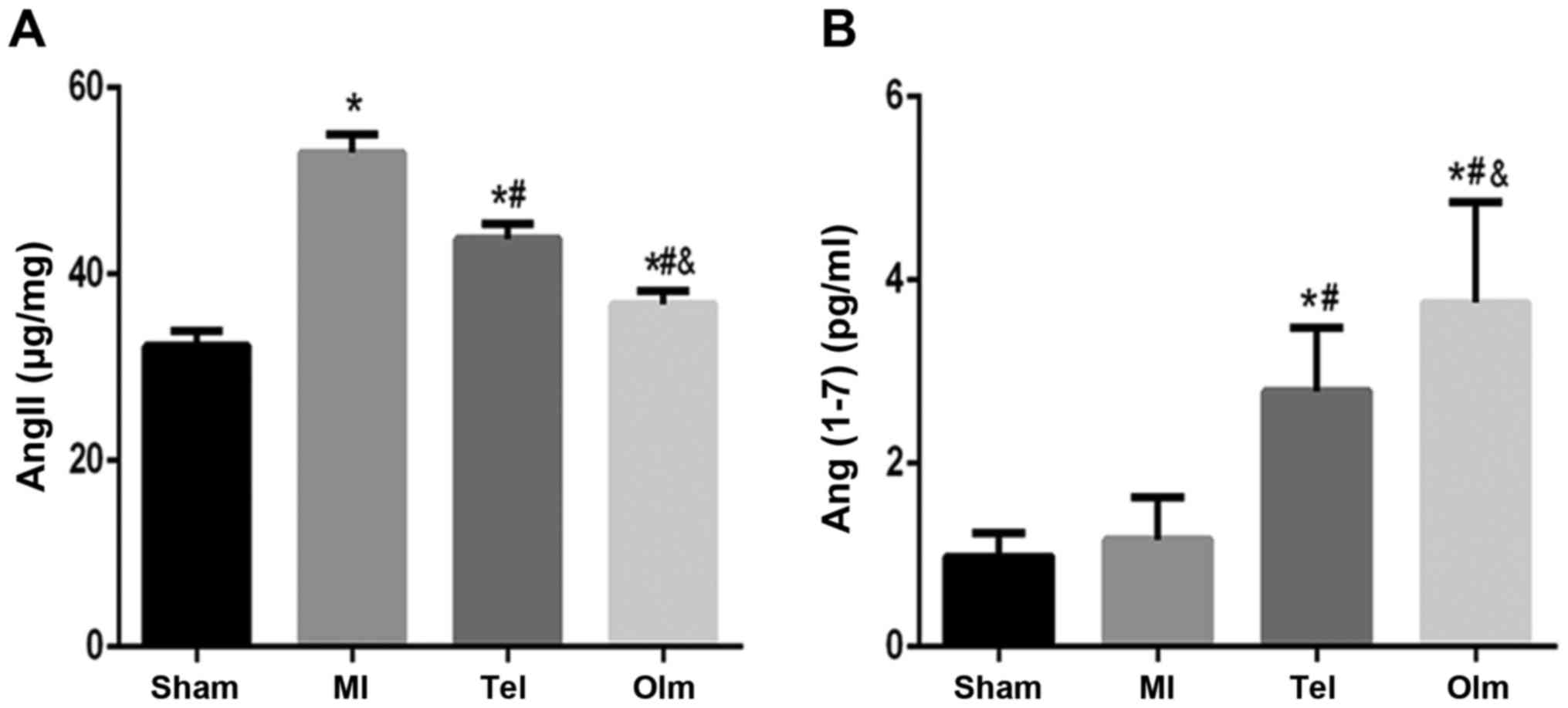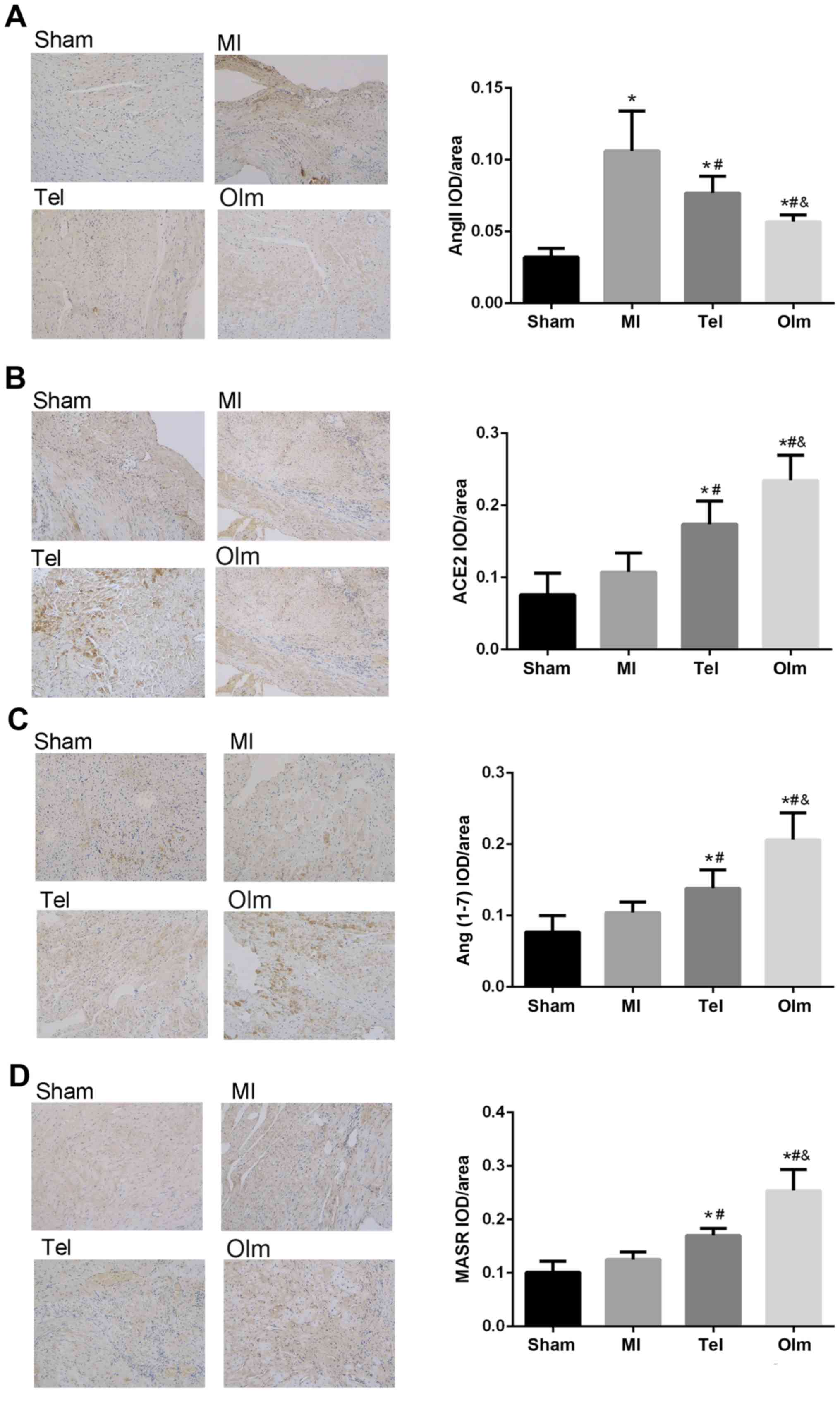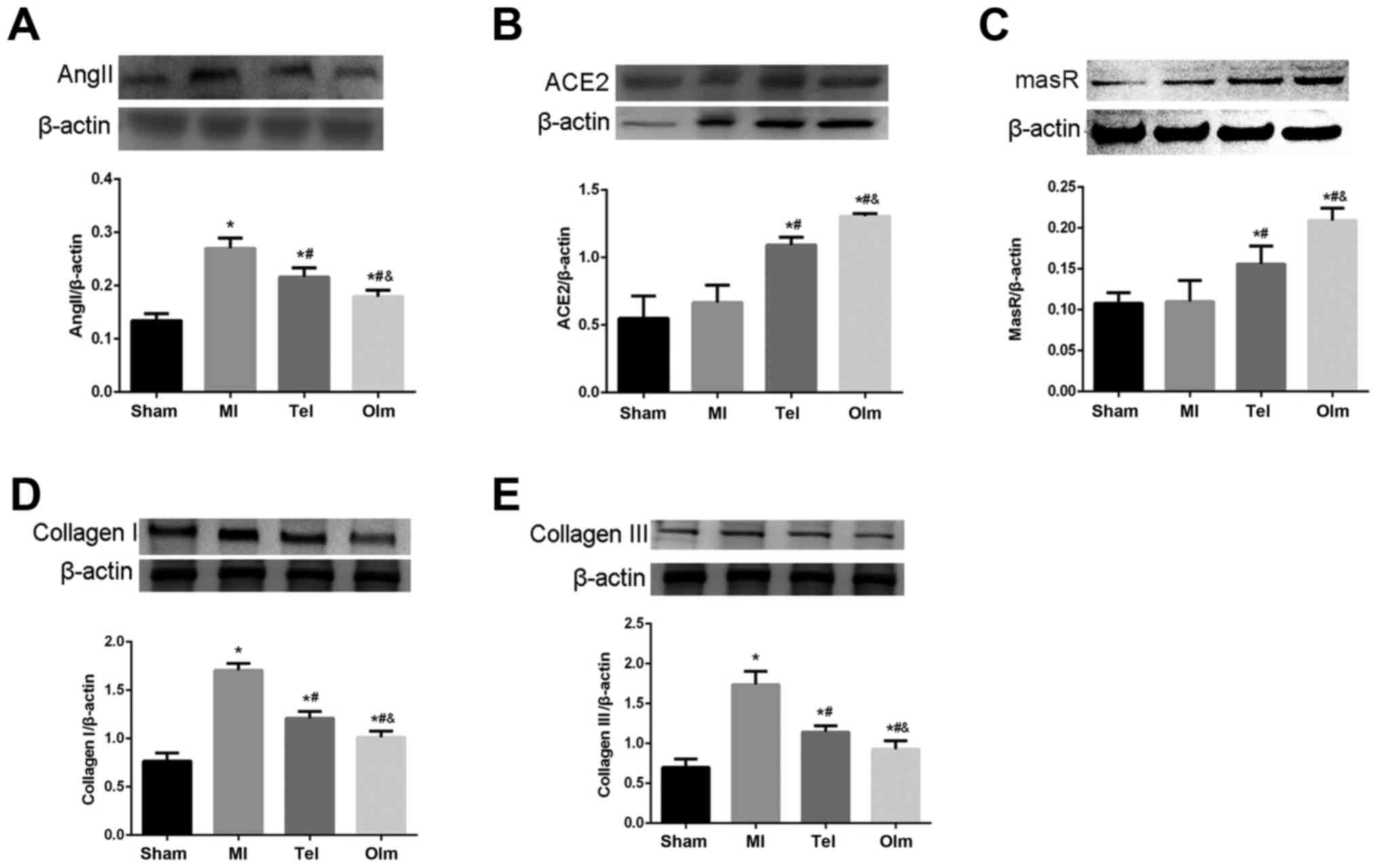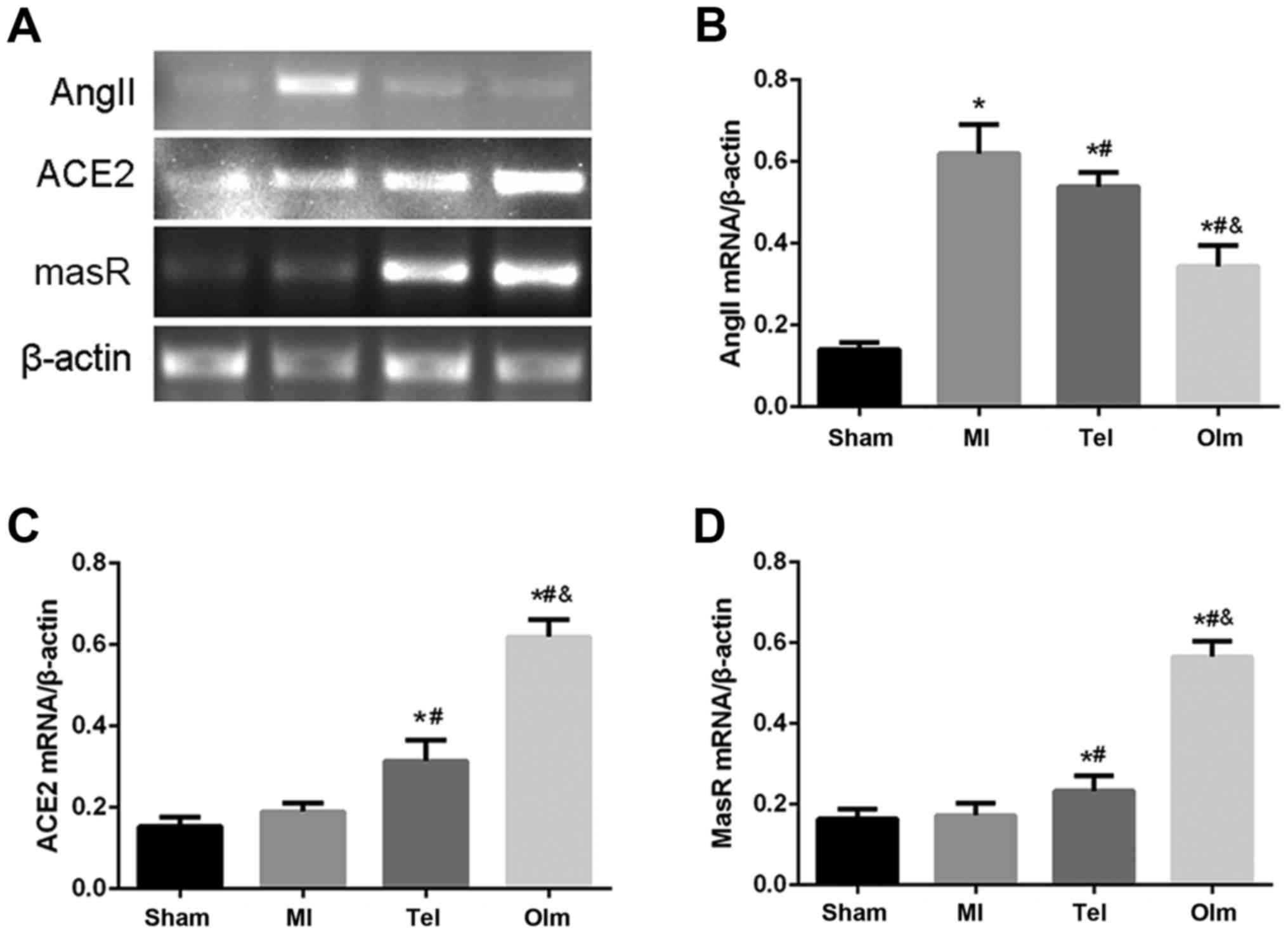|
1
|
Mendis S, Davis S and Norrving B:
Organizational update: The world health organization global status
report on noncommunicable diseases 2014; one more landmark step in
the combat against stroke and vascular disease. Stroke.
46:e121–e122. 2015. View Article : Google Scholar : PubMed/NCBI
|
|
2
|
Houston Miller N: Cardiovascular risk
reduction with Renin-Angiotensin aldosterone system blockade. Nurs
Res Pract 2010. 1017492010.
|
|
3
|
Schmieder RE, Hilgers KF, Schlaich MP and
Schmidt BM: Renin-angiotensin system and cardiovascular risk.
Lancet. 369:1208–1219. 2007. View Article : Google Scholar : PubMed/NCBI
|
|
4
|
Ferrario CM and Strawn WB: Role of the
renin-angiotensin-aldosterone system and proinflammatory mediators
in cardiovascular disease. Am J Cardiol. 98:121–128. 2006.
View Article : Google Scholar : PubMed/NCBI
|
|
5
|
Mehta PK and Griendling KK: Angiotensin II
cell signaling: Physiological and pathological effects in the
cardiovascular system. Am J Physiol Cell Physiol. 292:C82–C97.
2007. View Article : Google Scholar : PubMed/NCBI
|
|
6
|
Chappell MC: Nonclassical
renin-angiotensin system and renal function. Compr Physiol.
2:2733–2752. 2012.PubMed/NCBI
|
|
7
|
McKinney CA, Fattah C, Loughrey CM,
Milligan G and Nicklin SA: Angiotensin-(1–7) and angiotensin-(1–9):
Function in cardiac and vascular remodelling. Clin Sci (Lond).
126:815–827. 2014. View Article : Google Scholar : PubMed/NCBI
|
|
8
|
Varagic J, Ahmad S, Nagata S and Ferrario
CM: ACE2: Angiotensin II/angiotensin-(1–7) balance in cardiac and
renal injury. Curr Hypertens Rep. 16:4202014. View Article : Google Scholar : PubMed/NCBI
|
|
9
|
Ocaranza MP, Michea L, Chiong M, Lagos CF,
Lavandero S and Jalil JE: Recent insights and therapeutic
perspectives of angiotensin-(1–9) in the cardiovascular system.
Clin Sci (Lond). 127:549–557. 2014. View Article : Google Scholar : PubMed/NCBI
|
|
10
|
Moritani T, Iwai M, Kanno H, Nakaoka H,
Iwanami J, Higaki T, Ishii E and Horiuchi M: ACE2 deficiency
induced perivascular fibrosis and cardiac hypertrophy during
postnatal development in mice. J Am Soc Hypertens. 7:259–266. 2013.
View Article : Google Scholar : PubMed/NCBI
|
|
11
|
Iwanami J, Mogi M, Tsukuda K, Wang XL,
Nakaoka H, Ohshima K, Chisaka T, Bai HY, Kanno H, Min LJ and
Horiuchi M: Role of angiotensin-converting enzyme
2/angiotensin-(1–7)/Mas axis in the hypotensive effect of
azilsartan. Hypertens Res. 37:616–620. 2014. View Article : Google Scholar : PubMed/NCBI
|
|
12
|
Zhang Z, Chen L, Zhong J, Gao P and Oudit
GY: ACE2/Ang-(1–7) signaling and vascular remodeling. Sci China
Life Sci. 57:802–808. 2014. View Article : Google Scholar : PubMed/NCBI
|
|
13
|
Zhang Y, Li B, Wang B, Zhang J, Wu J and
Morgan T: Alteration of cardiac ACE2/Mas expression and cardiac
remodelling in rats with aortic constriction. Chin J Physiol.
57:335–342. 2014. View Article : Google Scholar : PubMed/NCBI
|
|
14
|
Liang B, Li Y, Han Z, Xue J, Zhang Y, Jia
S and Wang C: ACE2-Ang (1–7) axis is induced in pressure overloaded
rat model. Int J Clin Exp Pathol. 8:1443–1450. 2015.PubMed/NCBI
|
|
15
|
Nemoto W, Ogata Y, Nakagawasai O, Yaoita
F, Tadano T and Tan-No K: Angiotensin (1–7) prevents angiotensin
II-induced nociceptive behaviour via inhibition of p38 MAPK
phosphorylation mediated through spinal Mas receptors in mice. Eur
J Pain. 18:1471–1479. 2014. View
Article : Google Scholar : PubMed/NCBI
|
|
16
|
Zheng J, Li G, Chen S, Bihl J, Buck J, Zhu
Y, Xia H, Lazartigues E, Chen Y and Olson JE: Activation of the
ACE2/Ang-(1–7)/Mas pathway reduces oxygen-glucose
deprivation-induced tissue swelling, ROS production, and cell death
in mouse brain with angiotensin II overproduction. Neuroscience.
273:39–51. 2014. View Article : Google Scholar : PubMed/NCBI
|
|
17
|
Livak KJ and Schmittgen TD: Analysis of
relative gene expression data using real-time quantitative PCR and
the 2(−Delta Delta C(T)) method. Methods. 25:402–408. 2001.
View Article : Google Scholar : PubMed/NCBI
|
|
18
|
de la Sierra A: Renin-angiotensin system
blockade and reduction of cardiovascular risk: Future perspectives.
Expert Rev Cardiovasc Ther. 9:1585–1591. 2011. View Article : Google Scholar : PubMed/NCBI
|
|
19
|
Wang X, Ye Y, Gong H, Wu J, Yuan J, Wang
S, Yin P, Ding Z, Kang L, Jiang Q, et al: The effects of different
angiotensin II type 1 receptor blockers on the regulation of the
ACE-AngII-AT1 and ACE2-Ang(1–7)-Mas axes in pressure
overload-induced cardiac remodeling in male mice. J Mol Cell
Cardiol. 97:180–190. 2016. View Article : Google Scholar : PubMed/NCBI
|
|
20
|
Tanno T, Tomita H, Narita I, Kinjo T,
Nishizaki K, Ichikawa H, Kimura Y, Tanaka M, Osanai T and Okumura
K: Olmesartan inhibits cardiac hypertrophy in mice overexpressing
renin independently of blood pressure: Its beneficial effects on
ACE2/Ang(1–7)/Mas Axis and NADPH oxidase expression. J Cardiovasc
Pharmacol. 67:503–509. 2016. View Article : Google Scholar : PubMed/NCBI
|
|
21
|
Segura AM, Frazier OH and Buja LM:
Fibrosis and heart failure. Heart Fail Rev. 19:173–185. 2014.
View Article : Google Scholar : PubMed/NCBI
|
|
22
|
Schnee JM and Hsueh WA: Angiotensin II,
adhesion, and cardiac fibrosis. Cardiovasc Res. 46:264–268. 2000.
View Article : Google Scholar : PubMed/NCBI
|
|
23
|
Lindsey ML, Iyer RP, Zamilpa R,
Yabluchanskiy A, DeLeon-Pennell KY, Hall ME, Kaplan A, Zouein FA,
Bratton D, Flynn ER, et al: A novel collagen matricryptin reduces
left ventricular dilation post-myocardial infarction by promoting
scar formation and angiogenesis. J Am Coll Cardiol. 66:1364–1374.
2015. View Article : Google Scholar : PubMed/NCBI
|
|
24
|
Chamsi-Pasha MA, Shao Z and Tang WH:
Angiotensin-converting enzyme 2 as a therapeutic target for heart
failure. Curr Heart Fail Rep. 11:58–63. 2014. View Article : Google Scholar : PubMed/NCBI
|
|
25
|
Burrell LM, Risvanis J, Kubota E, Dean RG,
MacDonald PS, Lu S, Tikellis C, Grant SL, Lew RA, Smith AI, et al:
Myocardial infarction increases ACE2 expression in rat and humans.
Eur Heart J. 26:369–375, 322–324. 2005. View Article : Google Scholar : PubMed/NCBI
|
|
26
|
Dong B, Yu QT, Dai HY, Gao YY, Zhou ZL,
Zhang L, Jiang H, Gao F, Li SY, Zhang YH, et al:
Angiotensin-converting enzyme-2 overexpression improves left
ventricular remodeling and function in a rat model of diabetic
cardiomyopathy. J Am Coll Cardiol. 59:739–747. 2012. View Article : Google Scholar : PubMed/NCBI
|
|
27
|
Montaigne D, Coisne A, Marechal X and
Staels B: Comment on Patel et al: ACE2 deficiency worsens
epicardial adipose tissue inflammation and cardiac dysfunction in
response to diet-induced obesity. Diabetes 2016;65:85-95. Diabetes.
65:e1–e2. 2016. View Article : Google Scholar : PubMed/NCBI
|
|
28
|
Ortiz-Pérez JT, Riera M, Bosch X, de
Caralt TM, Perea RJ, Pascual J and Soler MJ: Role of circulating
angiotensin converting enzyme 2 in left ventricular remodeling
following myocardial infarction: A prospective controlled study.
PLoS One. 8:e616952013. View Article : Google Scholar : PubMed/NCBI
|
|
29
|
Wang J, Li N, Gao F, Song R, Zhu S and
Geng Z: Balance between angiotensin converting enzyme and
angiotensin converting enzyme 2 in patients with chronic heart
failure. J Renin Angiotensin Aldosterone Syst. 16:553–558. 2015.
View Article : Google Scholar : PubMed/NCBI
|
|
30
|
Wang Y, Tikellis C, Thomas MC and Golledge
J: Angiotensin converting enzyme 2 and atherosclerosis.
Atherosclerosis. 226:3–8. 2013. View Article : Google Scholar : PubMed/NCBI
|
|
31
|
Simões e Silva AC, Silveira KD, Ferreira
AJ and Teixeira MM: ACE2, angiotensin-(1–7) and Mas receptor axis
in inflammation and fibrosis. Br J Pharmacol. 169:477–492. 2013.
View Article : Google Scholar : PubMed/NCBI
|
|
32
|
Yang M, Zhao J, Xing L and Shi L: The
association between angiotensin-converting enzyme 2 polymorphisms
and essential hypertension risk: A meta-analysis involving 14,122
patients. J Renin Angiotensin Aldosterone Syst. 16:1240–1244. 2015.
View Article : Google Scholar : PubMed/NCBI
|
|
33
|
Wang SX, Tao T, Fu ZQ, Xie XZ, Wang H and
Wang YT: Polymorphisms of angiotensin-converting enzyme 2 gene
confer a risk to lone atrial fibrillation in Chinese male patients.
Chin Med J (Engl). 126:4608–4611. 2013.PubMed/NCBI
|
|
34
|
Burrell LM, Harrap SB, Velkoska E and
Patel SK: The ACE2 gene: Its potential as a functional candidate
for cardiovascular disease. Clin Sci (Lond). 124:65–76. 2013.
View Article : Google Scholar : PubMed/NCBI
|
|
35
|
Lin L, Liu X, Xu J, Weng L, Ren J, Ge J
and Zou Y: Mas receptor mediates cardioprotection of
angiotensin-(1–7) against Angiotensin II-induced cardiomyocyte
autophagy and cardiac remodelling through inhibition of oxidative
stress. J Cell Mol Med. 20:48–57. 2016. View Article : Google Scholar : PubMed/NCBI
|
|
36
|
Singh K, Sharma K, Singh M and Sharma PL:
Possible mechanism of the cardio-renal protective effects of
AVE-0991, a non-peptide Mas-receptor agonist, in diabetic rats. J
Renin Angiotensin Aldosterone Syst. 13:334–340. 2012. View Article : Google Scholar : PubMed/NCBI
|
|
37
|
Tallant EA, Ferrario CM and Gallagher PE:
Angiotensin-(1–7) inhibits growth of cardiac myocytes through
activation of the mas receptor. Am J Physiol Heart Circ Physiol.
289:H1560–H1566. 2005. View Article : Google Scholar : PubMed/NCBI
|
|
38
|
Zhao W, Zhao T, Chen Y and Sun Y:
Angiotensin 1–7 promotes cardiac angiogenesis following infarction.
Curr Vasc Pharmacol. 13:37–42. 2015. View Article : Google Scholar : PubMed/NCBI
|



